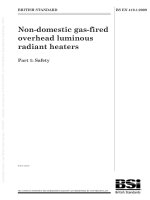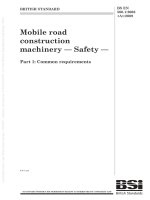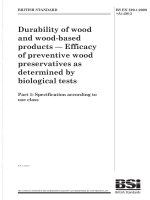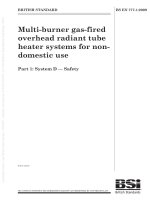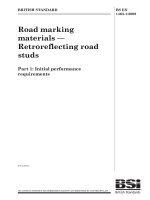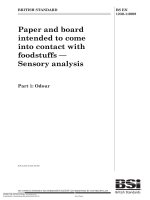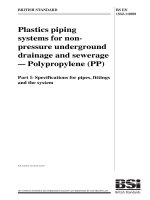Bsi bs en 61482 1 1 2009
Bạn đang xem bản rút gọn của tài liệu. Xem và tải ngay bản đầy đủ của tài liệu tại đây (1.53 MB, 44 trang )
BS EN 61482-1-1:2009
BSI Standards Publication
Live working — Protective
clothing against the thermal
hazards of an electric arc
Part 1-1: Test methods — Method 1:
Determination of the arc rating (ATPV
or EBT50) of flame resistant materials
for clothing
BRITISH STANDARD
BS EN 61482-1-1:2009
National foreword
This British Standard is the UK implementation of EN 61482-1-1:2009. It is
identical to IEC 61482-1-1:2009. It supersedes DD CLC/TS 61482-1:2003
which is withdrawn.
The UK participation in its preparation was entrusted to Technical Committee
PEL/78, Tools for live working.
A list of organizations represented on this committee can be obtained on
request to its secretary.
This publication does not purport to include all the necessary provisions of a
contract. Users are responsible for its correct application.
© BSI 2010
ISBN 978 0 580 60867 4
ICS 13.220.40; 29.260.99
Compliance with a British Standard cannot confer immunity from
legal obligations.
This British Standard was published under the authority of the Standards
Policy and Strategy Committee on 31 July 2010.
Amendments issued since publication
Amd. No.
Date
Text affected
BS EN 61482-1-1:2009
EUROPEAN STANDARD
EN 61482-1-1
NORME EUROPÉENNE
July 2009
EUROPÄISCHE NORM
ICS 13.220.40; 29.260
Supersedes CLC/TS 61482-1:2003
English version
Live working Protective clothing against the thermal hazards of an electric arc Part 1-1: Test methods Method 1: Determination of the arc rating (ATPV or EBT50)
of flame resistant materials for clothing
(IEC 61482-1-1:2009)
Travaux sous tension Vêtements de protection contre les
dangers thermiques d’un arc électrique Partie 1-1: Méthodes d'essai Méthode 1: Détermination
de la caractéristique d'arc
(ATPV ou EBT50) de matériaux
résistant à la flamme pour vêtements
(CEI 61482-1-1:2009)
Arbeiten unter Spannung Schutzkleidung gegen thermische
Gefahren eines Lichtbogens Teil 1-1: Prüfverfahren Verfahren 1: Bestimmung
der Lichtbogenkennwerte
(ATPV oder EBT50) von schwer
entflammbaren Bekleidungsstoffen
(IEC 61482-1-1:2009)
This European Standard was approved by CENELEC on 2009-06-01. CENELEC members are bound to comply
with the CEN/CENELEC Internal Regulations which stipulate the conditions for giving this European Standard
the status of a national standard without any alteration.
Up-to-date lists and bibliographical references concerning such national standards may be obtained on
application to the Central Secretariat or to any CENELEC member.
This European Standard exists in three official versions (English, French, German). A version in any other
language made by translation under the responsibility of a CENELEC member into its own language and notified
to the Central Secretariat has the same status as the official versions.
CENELEC members are the national electrotechnical committees of Austria, Belgium, Bulgaria, Cyprus, the
Czech Republic, Denmark, Estonia, Finland, France, Germany, Greece, Hungary, Iceland, Ireland, Italy, Latvia,
Lithuania, Luxembourg, Malta, the Netherlands, Norway, Poland, Portugal, Romania, Slovakia, Slovenia, Spain,
Sweden, Switzerland and the United Kingdom.
CENELEC
European Committee for Electrotechnical Standardization
Comité Européen de Normalisation Electrotechnique
Europäisches Komitee für Elektrotechnische Normung
Central Secretariat: Avenue Marnix 17, B - 1000 Brussels
© 2009 CENELEC -
All rights of exploitation in any form and by any means reserved worldwide for CENELEC members.
Ref. No. EN 61482-1-1:2009 E
BS EN 61482-1-1:2009
EN 61482-1-1:2009
-2-
Foreword
The text of document 78/793/FDIS, future edition 1 of IEC 61482-1-1, prepared by IEC TC 78, Live
working, was submitted to the IEC-CENELEC parallel vote and was approved by CENELEC as
EN 61482-1-1 on 2009-06-01.
This European Standard supersedes CLC/TS 61482-1:2003.
EN 61482-1-1:2009 includes
CLC/TS 61482-1:2003:
the
following
significant
technical
change
with
respect
to
– addition of a detailed analysis of the sensor response.
The following dates were fixed:
– latest date by which the EN has to be implemented
at national level by publication of an identical
national standard or by endorsement
(dop)
2010-03-01
– latest date by which the national standards conflicting
with the EN have to be withdrawn
(dow)
2012-06-01
Annex ZA has been added by CENELEC.
__________
Endorsement notice
The text of the International Standard IEC 61482-1-1:2009 was approved by CENELEC as a European
Standard without any modification.
In the official version, for Bibliography, the following notes have to be added for the standards indicated:
IEC 61482-1-2
NOTE Harmonized as EN 61482-1-2:2007 (not modified).
ISO 5077
NOTE Harmonized as EN ISO 5077:2008 (not modified).
__________
BS EN 61482-1-1:2009
-3-
EN 61482-1-1:2009
Annex ZA
(normative)
Normative references to international publications
with their corresponding European publications
The following referenced documents are indispensable for the application of this document. For dated
references, only the edition cited applies. For undated references, the latest edition of the referenced
document (including any amendments) applies.
NOTE When an international publication has been modified by common modifications, indicated by (mod), the relevant EN/HD
applies.
Publication
Year
Title
EN/HD
Year
ISO 3175-2
-
1)
ISO 6330
-
1)
Textiles - Domestic washing and drying
procedures for textile testing
EN ISO 6330
2000
ISO 9151
-
1)
Protective clothing against heat and flame Determination of heat transmission on
exposure to flame
-
-
ISO 15025
2000
Protective clothing - Protection against heat
and flame - Method of test for limited flame
spread
EN ISO 15025
2002
1)
Undated reference.
2)
Valid edition at date of issue.
Textiles - Professional care, drycleaning and EN ISO 3175-2
wetcleaning of fabrics and garments Part 2: Procedure for testing performance
when cleaning and finishing using
tetrachloroethene
1998
2)
2)
BS EN 61482-1-1:2009
–2–
61482-1-1 © IEC:2009
CONTENTS
1
Scope ...............................................................................................................................6
2
Normative references .......................................................................................................6
3
Terms, definitions and symbols ........................................................................................7
4
3.1 Terms and definitions ..............................................................................................7
3.2 Symbols and units ................................................................................................. 11
Principle of the test methods .......................................................................................... 11
5
4.1 Test method A ....................................................................................................... 11
4.2 Test method B ....................................................................................................... 12
Significance and use of the test methods........................................................................ 12
6
Test apparatus ............................................................................................................... 12
6.1
6.2
6.3
6.4
6.5
6.6
6.7
6.8
7
General ................................................................................................................. 12
Method A – Arrangement of the two-sensor panels ................................................ 13
Method A – Panel construction .............................................................................. 14
Method B – Arrangement of the mannequins ......................................................... 15
Method B – Mannequin construction ...................................................................... 17
Sensor response ................................................................................................... 18
Calorimeter construction........................................................................................ 18
Supply bus and electrodes .................................................................................... 20
6.8.1 General ..................................................................................................... 20
6.8.2 Electrodes ................................................................................................. 21
6.8.3 Fuse wire .................................................................................................. 22
6.9 Electric supply ....................................................................................................... 22
6.10 Test-circuit control................................................................................................. 22
6.11 Data acquisition system......................................................................................... 22
Precautions .................................................................................................................... 22
8
Specimen preparation..................................................................................................... 23
8.1
9
Test specimens ..................................................................................................... 23
8.1.1 Test specimens for method A: two-sensor panel test ................................. 23
8.1.2 Test specimens for method B: four-sensor mannequin............................... 23
8.2 Laundry conditioning of test specimens ................................................................. 23
Calibration ...................................................................................................................... 23
9.1
9.2
9.3
Data acquisition system precalibration .................................................................. 23
Calorimeter calibration check ................................................................................ 23
Arc exposure and apparatus calibration for the two-sensor panels and the
monitoring sensors ................................................................................................ 24
9.3.1 Test apparatus .......................................................................................... 24
9.3.2 Positioning of the two-sensor panels, mannequins and monitoring
sensors ..................................................................................................... 24
9.3.3 Apparatus calibration for the two-sensor panels and monitoring
sensors ..................................................................................................... 24
9.4 Confirmation of test apparatus setting ................................................................... 24
10 Test apparatus care and maintenance ............................................................................ 25
10.1 Surface reconditioning........................................................................................... 25
10.2 Care of sensor panels and mannequins ................................................................. 25
10.3 Care of electrodes ................................................................................................. 25
BS EN 61482-1-1:2009
61482-1-1 © IEC:2009
–3–
11 Test procedures ............................................................................................................. 25
11.1 Test parameters .................................................................................................... 25
11.2 Sequence of tests ................................................................................................. 25
11.2.1 Panels ....................................................................................................... 25
11.2.2 Mannequins ............................................................................................... 25
11.2.3 Test criteria ............................................................................................... 25
11.3 Initial temperature ................................................................................................. 26
11.4 Specimen mounting ............................................................................................... 26
11.4.1 Method A panels........................................................................................ 26
11.4.2 Method B mannequins ............................................................................... 27
11.5 Specimen characteristics....................................................................................... 27
11.6 Test protocol ......................................................................................................... 28
12 Interpretation of results .................................................................................................. 28
12.1 Heat transfer ......................................................................................................... 28
12.1.1 Determining time zero ............................................................................... 28
12.1.2 Plotting sensor response ........................................................................... 28
12.1.3 Sensor response versus Stoll curve ........................................................... 30
12.1.4 Determination of heat attenuation factor (HAF) .......................................... 32
12.2 Determination of breakopen threshold energy, E BT50 ........................................... 33
12.3 Arc rating .............................................................................................................. 33
12.4 Visual inspection ................................................................................................... 33
13 Test report...................................................................................................................... 34
Annex A (normative) Measurement of char length ................................................................ 36
Annex B (informative) Logistic regression technique ............................................................ 37
Annex C (informative) Heat attenuation factor ...................................................................... 39
Bibliography.......................................................................................................................... 40
Figure 1 – Method A – Arrangement of three two-sensor panels with monitoring
sensors (plan view) ............................................................................................................... 13
Figure 2 – Method A – Two-sensor panel (face view) with monitoring sensors ...................... 14
Figure 3 – Method A – Sliding two-sensor panel ................................................................... 15
Figure 4 – Supply bus and arc electrodes showing the position of mannequin(s) and
monitoring sensors ............................................................................................................... 16
Figure 5 – Positioning of electrodes and monitoring sensors ................................................. 17
Figure 6 – Four-sensor mannequin, front view ...................................................................... 18
Figure 7 – Calorimeter and thermocouple details .................................................................. 19
Figure 8 – Typical installation of the copper sensor mounted in the panel and the
calorimeter mounted in the monitoring sensor ....................................................................... 20
Figure 9 – Example of supply bus and arc electrodes for panels ........................................... 21
Figure 10 – Typical material clamping assembly ................................................................... 27
Figure 11 – Typical sensor temperature-rise curve with time scale and baseline
correction ............................................................................................................................. 29
Table 1 – Human tissue tolerance to heat, second-degree burn [1] ....................................... 31
Table A.1 – Total tearing load ............................................................................................... 36
BS EN 61482-1-1:2009
–6–
61482-1-1 © IEC:2009
LIVE WORKING –
PROTECTIVE CLOTHING AGAINST THE THERMAL
HAZARDS OF AN ELECTRIC ARC –
Part 1-1: Test methods –
Method 1: Determination of the arc rating
(ATPV or E BT50 ) of flame resistant materials for clothing
1
Scope
This part of IEC 61482 specifies test methods to measure the arc thermal performance value
of materials intended for use in heat- and flame-resistant clothing for workers exposed to the
thermal effects of electric arcs and the function of garments using these materials. These test
methods measure the arc thermal performance value of materials which meet the following
requirements: less than 100 mm char length and less than 2 s afterflame after removal from
flame, when tested in accordance with ISO 15025, procedure B (bottom-edge ignition) on the
outer material, and the char length measured using a modified ISO method as described in
Annex A.
These methods are used to measure and describe the properties of materials, products,
assemblies or garments, in response to convective and radiant energy generated by an
electric arc in open air under controlled laboratory conditions.
The materials used in these methods are in the form of flat specimens for method A and
garments for method B.
Method A is used to determine the arc rating of materials and material assemblies when
tested in a flat configuration.
Method B is used to measure garment response, not arc rating, to an arc exposure including
all the garment findings, sewing thread, fastenings, fabrics and other accessories when tested
on a male mannequin torso. Method B is also used for accident replication.
It is the responsibility of the user of this part of IEC 61482 to establish appropriate safety and
health practices prior to use. For specific precautions, see Clause 7.
The test methods in this part of IEC 61482 are not directed to classify by protection classes.
Methods determining protection classes are prescribed in IEC 61482-1-2.
2
Normative references
The following referenced documents are indispensable for the application of this document.
For dated references, only the edition cited applies. For undated references, the latest edition
of the referenced document (including any amendments) applies.
ISO 3175-2, Textiles – Professional care, drycleaning and wetcleaning of fabrics and
garments – Part 2: Procedure for testing performance when cleaning and finishing using
tetrachloroethene
ISO 6330, Textiles – Domestic washing and drying procedures for textile testing
BS EN 61482-1-1:2009
61482-1-1 © IEC:2009
–7–
ISO 9151, Protective clothing against heat and flame – Determination of heat transmission on
exposure to flame
ISO 15025:2000, Protective clothing – Protection against heat and flame – Method of test for
limited flame spread
3
Terms, definitions and symbols
For the purposes of this document, the following terms, definitions and symbols apply.
NOTE
For definitions of other textile terms related to the topic, see ASTM D-123 [7] 1) .
3.1
Terms and definitions
3.1.1
arc duration
time duration of the arc
NOTE
Arc duration is expressed in s.
3.1.2
arc energy
W arc
electrical energy supplied to the arc and converted in the arc; sum of the instantaneous arc
voltage values multiplied by the instantaneous arc current values multiplied by the
incremental time values during the arc duration
NOTE
Arc energy is expressed in kJ or kW·s.
3.1.3
arc gap
distance between the arc electrodes
NOTE
Arc gap is expressed in mm.
3.1.4
arc rating
value attributed to materials or material systems that describes their performance to exposure
to an electrical arc discharge
NOTE The arc rating is expressed in kW·s/m 2 – or optionally in cal/cm 2 – and is derived from the determined
value of ATPV or E BT 50 (should a material or material system exhibit a breakopen response below the ATPV value).
3.1.5
arc thermal performance value (ATPV)
in arc testing, the incident energy on a material or a multilayer system of materials that results
in a 50% probability that sufficient heat transfer through the tested specimen is predicted to
cause the onset of a second degree skin burn injury based on the Stoll curve, without
breakopen
NOTE
ATPV is expressed in kJ/m 2 or kW·s/m 2 (cal/cm 2 ).
3.1.6
arc voltage
voltage across the arc
NOTE
Arc voltage is expressed in V.
—————————
1) Figures in square brackets refer to the bibliography.
BS EN 61482-1-1:2009
–8–
61482-1-1 © IEC:2009
3.1.7
asymmetrical arc current
total arc current produced during closure; it includes a direct component and a symmetrical
component
NOTE
Asymmetrical arc current is expressed in A.
3.1.8
breakopen
in electric arc testing, material response evidenced by the formation of one or more openings
in the material which may allow flame to pass through the material
NOTE 1 The specimen is considered to exhibit breakopen when any opening is at least 300 mm 2 in area or at
least 25 mm in any dimension. A single thread across the opening does not reduce the size of the hole for the
purposes of this part of IEC 61482.
NOTE 2 A multilayer specimen is considered to exhibit breakopen when all layers show formation of one or more
openings.
3.1.9
breakopen threshold energy
E BT50
incident energy on a fabric or material that results in a 50 % probability that sufficient heat
transfer through the tested specimen is predicted to cause the tested specimen to break open
NOTE
The breakopen threshold energy is expressed in kJ/m 2 or kW·s/m 2 (cal/cm 2 ).
3.1.10
burning time
time for which a flame is visible after exposure to arc
NOTE
Burning time is expressed in s.
3.1.11
calorimeter
device for measuring the heat flux and incident energy
3.1.12
charring
formation of carbonaceous residue as the result of pyrolysis or incomplete combustion
3.1.13
closure
point on supply current waveform where the arc is initiated
3.1.14
clothing
assembly of garments worn by workers
3.1.15
delta peak temperature
ΔT p
difference between the maximum temperature and the initial temperature of the sensor during
the test exposure time
NOTE
Delta peak temperature is expressed in °C.
3.1.16
dripping
material response evidenced by flowing of the fibre polymer
BS EN 61482-1-1:2009
61482-1-1 © IEC:2009
–9–
3.1.17
electric arc
self-maintained gas conduction for which most of the charge carriers are electrons supplied
by primary-electron emission
[IEV 121-13-12]
NOTE During live working, the electric arc is generated by gas ionisation arising from an unintentional electrical
conducting connection or breakdown between live parts or a live part and the earth path of an electrical installation
or an electrical device. During testing, the electric arc is initiated by the blowing of a fuse wire.
3.1.18
embrittlement
formation of a brittle residue as the result of pyrolysis or incomplete combustion
3.1.19
exposure time
shortly before, during and for 30 s after an arc thermal exposure has been initiated
3.1.20
garment
single item of clothing which may consists of single or multiple layers
3.1.21
heat attenuation factor (HAF)
per cent of the incident energy which is blocked by a material at an incident energy level
equal to ATPV
3.1.22
heat flux
q
thermal intensity of an electric arc indicated by the amount of energy transmitted per unit
surface area and time
NOTE
Heat flux is expressed in kW/m 2 .
3.1.23
ignition
initiation of combustion
3.1.24
incident energy
Ei
heat energy (total heat) received at a unit surface area as a result of an electric arc
NOTE 1
The heat energy is measured as a proportional peak temperature rise ΔT p of a calorimeter sensor.
NOTE 2
Incident energy is expressed in kJ/m 2 or kW·s/m 2 (cal/cm 2 ).
NOTE 3 In an arc test, incident energy for a specimen is determined from the average temperature-rise response
of the two monitoring sensors adjacent to the test specimen.
3.1.25
material
fabric or other substances of which the garment is made, this may consist of single or multiple
layers
BS EN 61482-1-1:2009
– 10 –
61482-1-1 © IEC:2009
3.1.26
material response
subjective observation of the reaction of the material to an electric arc indicated by the
following characteristics: burning time (after flame, ignition), breakopen, melting, dripping,
charring, embrittlement, shrinkage
3.1.27
melting
material response evidenced by softening and deformation of the fibre polymer
3.1.28
mix zone
range of incident energies, which can result in either a positive or negative outcome for
predicted second-degree burn injury, breakopen or underlayer ignition
NOTE 1 The low value of the range begins with the lowest incident energy indicating a positive result, and the
high value of the range is the highest incident energy indicating a negative result.
NOTE 2 A mix zone is established when the highest incident energy with a negative result is greater than the
lowest incident energy with a positive result.
3.1.29
monitoring sensor
monitor sensor
sensor mounted on each side of the panel or mannequin, using the calorimeters not covered
by test specimen and used to measure incident energy
3.1.30
peak arc current
maximum value of the a.c. arc current
NOTE
Peak arc current is expressed in A.
3.1.31
protective clothing
clothing which covers or replaces personal clothing, and which is designed to provide
protection against one or more hazards
[Definition 3.4 of ISO 13688 [6]]
3.1.32
r.m.s. arc current
root mean square of the a.c. arc current
NOTE
RMS arc current is expressed in A.
3.1.33
sensor
assembly with a calorimeter and a non-conductive heat-resistant material in which the
calorimeter is mounted
3.1.34
shrinkage
material response evidenced by reduction in specimen size
3.1.35
Stoll curve
curve of thermal energy and time produced from data on human tissue tolerance to heat and
used to predict the onset of second-degree burn injury
NOTE
See Table 1 and Equation (5).
BS EN 61482-1-1:2009
61482-1-1 © IEC:2009
– 11 –
3.1.36
time to delta peak temperature
t max
time from beginning of the initiation of the arc to the time the delta peak temperature is
reached
NOTE
Time to delta peak temperature is expressed in s.
3.1.37
X/R ratio
ratio of system inductive reactance to resistance
NOTE The X/R ratio is proportional to the L/R ratio of time constant, and is, therefore, indicative of the rate of
decay of any d.c. offset. A large X/R ratio corresponds to a large time constant and a slow rate of decay.
3.2
Symbols and units
ATPV
arc thermal performance value
kW·s/m 2 (see incident energy)
Cp
heat capacity
J/g °C
E BT50
breakopen threshold energy
kW·s/m 2 (see incident energy)
Ei
incident energy
kJ/m 2 or kW·s/m 2
E transmitted
transmitted energy
kJ/m 2 or kW·s/m 2
HAF
heat attenuation factor
haf
HAF data point
Q
Heat energy
J/cm 2
q
heat flux
kW/m 2
T
measured temperature
°C
t
time
s
W arc
arc energy
kJ, kW·s
NOTE
1 J/g °K = 4,186 8 cal/g °K
1 kJ/m 2 = 1 kW.s/m 2 = 0,1 J/cm 2 = 0,023 885 cal/cm 2
1 cal/cm 2 = 41,868 kJ/m 2 = 41,868 kW.s/m 2 = 4,186 8 J/cm 2
4
4.1
Principle of the test methods
Test method A
The test method A specified in this standard determines the incident energy which would
predict a second-degree burn injury when the material(s) is (are) exposed to heat energy from
an electric arc.
During the tests, the amount of heat energy transferred by the material(s) is measured during
and after exposure to an electric arc.
The heat flux of the exposure and that transferred by the test specimen(s) are both measured
with copper slug calorimeter sensors. The change in temperature versus time is used, along
with the known thermo-physical properties of copper, to determine the respective heat
energies delivered to and through the specimens.
BS EN 61482-1-1:2009
– 12 –
61482-1-1 © IEC:2009
Material performance for this procedure is determined from the amount of heat transferred by
the specimen(s).
Heat transfer data is used to predict the onset of a second-degree burn using the Stoll curve.
The procedures incorporate incident-energy monitoring sensors.
Material response shall be further described by recording the observed effects of the electric
arc exposure on the specimens and using the terms given in 3.1.26.
4.2
Test method B
The test method B specified in this standard is used for evaluation of protective clothing
design or accident replication. Garments shall be evaluated with findings, pockets and
closures positioned as manufactured, but no arc rating can be reported due to the impact of
garment design such as pocketing and multilayer closures on the heat transfer to the sensors.
5
Significance and use of the test methods
The test method A measures the arc thermal performance value of materials intended for use
in flame-resistant clothing for workers exposed to electric arcs. The test method is intended
for the determination of the thermal performance value of a material by itself or in comparison
with other materials.
Because of the variability of the arc exposure, different heat transmission values may result
for individual sensors. The results of each sensor shall be evaluated in accordance with
Clause 12.
The test method B specified in this standard is used for evaluation of protective clothing
design. Garments made of materials or material systems previously tested according to
method A, shall be first tested as panels following method A. Then the garment using
materials previously tested are tested following method B.
The test methods maintain the specimen in a static vertical position and do not involve
movement, except that resulting from the exposure.
The test methods specify a standard set of exposure conditions. Different exposure conditions
may produce different results. In addition to the standard set of exposure conditions, other
conditions representative of the expected hazard may be used.
6
6.1
Test apparatus
General
The test apparatus shall consist of the following elements:
−
supply bus;
−
arc controller;
−
recorder or data acquisition system;
−
arc electrodes;
−
three two-sensor panels (method A) or one to three four-sensor mannequins (method B);
−
monitoring sensors for each panel or mannequin.
BS EN 61482-1-1:2009
61482-1-1 © IEC:2009
6.2
– 13 –
Method A – Arrangement of the two-sensor panels
Three two-sensor panels shall be used for each test and spaced at 120° as shown in Figure 1.
In addition, each two-sensor panel shall have two monitoring sensors. One monitoring sensor
shall be positioned on each side of the two-sensor panel as shown in Figure 2.
Dimensions in millimetres
IEC
801/09
Key
1
Monitoring sensor
Figure 1 – Method A – Arrangement of three two-sensor panels
with monitoring sensors (plan view)
BS EN 61482-1-1:2009
61482-1-1 © IEC:2009
– 14 –
Dimensions in millimetres
Key
1
Monitoring sensor
2
Sensor
IEC
802/09
Figure 2 – Method A – Two-sensor panel (face view) with monitoring sensors
6.3
Method A – Panel construction
Each two-sensor panel and monitoring sensor holder shall be constructed from nonconductive, heat-resistant material (for example, Marinite A, asbestos-free “Transite” Board,
oven insulation). Each two-sensor panel shall be 200 mm by a minimum of 550 mm as shown
in Figure 2. Each two-sensor panel and the monitoring sensors shall be adjustable from
200 mm to 600 mm from the centre line of the arc electrodes as shown in Figures 1 and 3.
Two sensors shall be mounted in the panel as shown in Figure 2. Each sensor shall be
mounted flush with the surface of the panel.
BS EN 61482-1-1:2009
61482-1-1 © IEC:2009
– 15 –
Dimensions in millimetres
IEC
803/09
Key
1
Monitoring sensor
3
Electrode
2
Sensor
4
Movable two-sensor panel mounted in insulating stand
5
Slide system provided by user shall include method to maintain alignment and locking device
Figure 3 – Method A – Sliding two-sensor panel
6.4
Method B – Arrangement of the mannequins
Up to three four-sensor mannequins shall be used for each test and spaced at a minimum
of 120° as shown in Figure 4. Each mannequin shall have two monitoring sensors.
One monitoring sensor shall be positioned on each side of the mannequin (and not fixed on
the mannequin) as shown in Figures 4 and 5.
NOTE The space around the arc electrodes may dictate the number of mannequins used. It has been found that
two mannequins provide the best working space when dressing the mannequins. The minimum 120° spacing
should be maintained.
BS EN 61482-1-1:2009
– 16 –
IEC
Front view
61482-1-1 © IEC:2009
804/09
IEC
Top view
Key
1
Monitoring sensor
2
Additional mannequin position
Figure 4 – Supply bus and arc electrodes showing the position of
mannequin(s) and monitoring sensors
805/09
BS EN 61482-1-1:2009
61482-1-1 © IEC:2009
– 17 –
Dimensions in millimetres
IEC
Key
1
Monitoring sensor
2
Electrode
806/09
Figure 5 – Positioning of electrodes and monitoring sensors
6.5
Method B – Mannequin construction
A male mannequin torso, size large, chest width (circumference: 1 067 mm ± 25 mm), made
from non-conductive fibreglass construction with a high temperature resin or other nonconductive, non-flammable high temperature materials shall be used.
NOTE
For clothing size measurements see also ISO 13688 [6].
The mannequin shall be constructed in an erect posture. The head may be removable;
the arms shall be detachable, straight and mounted in a vertical position to allow the test
specimen at the chest to be the closest point to the centre line of the arc. The arms may be
shortened to 100 mm to permit ease of specimen mounting. The mannequin shall use the
sensors described in Figures 7a and 7b and mounted as shown in Figure 6.
BS EN 61482-1-1:2009
61482-1-1 © IEC:2009
– 18 –
Dimensions in millimetres
IEC
807/09
Figure 6 – Four-sensor mannequin, front view
6.6
Sensor response
Sensor response shall be compared with the Stoll curve. Monitoring sensor response is
converted to incident energy in units of kW·s/m 2 by multiplying the temperature increase (ΔT)
by a factor based on the copper sensor mass, exposed sensor surface area, and temperature
corrected heat capacity of copper as described in 12.1.2.2 to 12.1.2.5.
6.7
Calorimeter construction
The calorimeter shall be constructed from electrical grade copper with one thermocouple wire
installed in the arrangement as shown in Figure 7a. The thermocouple wire shall be installed
in the calorimeter as shown in Figure 7b. Figure 8 gives a typical installation of the copper
sensor mounted in the panel and the calorimeter mounted in the monitoring sensor. For test
exposures above 2 512 kW·s/m 2 only, alternate calorimeters for the monitoring sensors may
be used, provided they are calibrated and have an appropriate response.
The exposed surface of the copper calorimeters shall be painted with a thin coating of a flat
black high temperature spray paint with an emissivity of >0,9. The painted sensor shall be
dried before use and present a uniformly applied coating (no visual thick spots or surface
irregularities).
NOTE An external heat source, for example an external heat lamp, may be required to completely drive off any
remaining organic carriers in a freshly painted surface.
For all parameters not defined in this standard, refer to ISO 9151 for a description of
calorimeter construction.
BS EN 61482-1-1:2009
61482-1-1 © IEC:2009
– 19 –
IEC
808/09
Key
1
Sensor of electrical grade copper, of 40 mm diameter
2
Thermocouple location
The central hole shall have a diameter of 1,2 mm and a depth of 1,3 mm.
Figure 7a – Installation of the thermocouple in the calorimeter
IEC
809/09
Key
1
Separate thermocouple wires
2
Position a thermocouple with total outer diameter of 0,254 mm. The plug shall be pressed into the hole
such as to fill it up completely. The separation point of the thermocouple wires shall be at the surface of
the copper disk, as shown in the drawing.
Figure 7b – Thermocouple wire installation – Hole detail and method of securing thermocouple
Figure 7 – Calorimeter and thermocouple details
BS EN 61482-1-1:2009
61482-1-1 © IEC:2009
– 20 –
IEC
810/09
Key
1
Electrical grade copper disk of 18 g , ∅ 40 mm, 1,6 mm
thick, (pinned in place)
4
Hole of 3,2 mm diameter
2
Insulation board, minimum thickness ~1,3 cm
5
Ledge, 1,6 mm × 1,6 mm
3
Type K (NiCr - NiAl) or
Type J (Fe - CuNi) thermocouple
6
Signal to data acquisition
Figure 8 – Typical installation of the copper sensor mounted in the panel and the
calorimeter mounted in the monitoring sensor
6.8
6.8.1
Supply bus and electrodes
General
The arrangement of the supply bus and arc electrodes is shown in Figure 9. This figure gives
an example of a structural arrangement of aluminium bus which is designed to reduce the
electromagnetic forces on the arc and thus centres the rotation of the arc along the centre line
between the electrodes. The arc shall be in a vertical position as shown.
BS EN 61482-1-1:2009
61482-1-1 © IEC:2009
– 21 –
IEC
811/09
Key
1
Coaxial bus supply
5
Panel
2
Bus
6
Insulating stand
3
Electrode
7
Insulator
4
Sensor
Figure 9 – Example of supply bus and arc electrodes for panels
6.8.2
Electrodes
The electrodes are made from a stainless steel rod (alloy type UNS-S30300 or type UNSS30400) of a suitable diameter and length which are practical for the test energies being
utilized.
BS EN 61482-1-1:2009
– 22 –
6.8.3
61482-1-1 © IEC:2009
Fuse wire
A fuse wire, connecting the ends of opposing electrodes tips, is used to initiate the arc. This
wire is consumed during the test; therefore, its mass shall be very small to reduce the chance
of molten metal burns. The fuse wire shall be a copper wire with a nominal diameter of
0,5 mm.
6.9
Electric supply
The electric supply shall be sufficient to allow for the discharge of an electric arc initiated with
a fuse wire, across a gap of up to 305 mm, with alternating arc current of 8 kA ±1 kA and with
arc duration from 0,05 s up to 1,5 s from a power-frequency supply, and a voltage sufficient to
maintain the arc for the whole duration of the test. Voltage of 2 000 V has proven to be
sufficient. The source impedance shall be much higher than the arc impedance so that the
r.m.s. current does not vary during the test. The X/R ratio of the test circuit shall be such that
the test current contains a d.c. component resulting in the first peak of the test current having
a magnitude of 2,3 times the symmetrical r.m.s. value.
6.10
Test-circuit control
Repeated exposures of the arc currents shall not deviate more than 2 % per test from the
selected test level. The make switch shall be capable of point on wave closing within
0,2 cycles from test to test such that the closing angle will produce maximum asymmetrical
current with an X/R ratio of the test circuit as stated in 6.9. The arc current, duration, and
voltage shall be measured. The arc current, duration, voltage and energy shall be displayed in
graph form and stored in digital format.
6.11
Data acquisition system
The system shall be capable of recording voltage, current and sufficient calorimeter outputs
as required by the test. The temperature data (copper calorimeter outputs) shall be acquired
at a minimum sampling rate of 20 samples per second per calorimeter. The acquisition system
shall be able to record temperatures to 400 °C. The temperature acquisition system shall
have at least a resolution of 0,1 °C and an accuracy of ±0,75 °C. It shall be capable of making
cold junction corrections and converting the millivolt signals from either the type J or K
thermocouple to temperature (complies with IEC 60584). The system current and voltage data
shall be acquired at a minimum rate of 2 000 samples per second. The current and voltage
acquisition system shall have at least a resolution of 1 % of the applied voltage and current.
Use isolating devices on the calorimeter outputs to protect the acquisition system.
7
Precautions
The test apparatus discharges large amounts of energy. In addition, the electric arc produces
very intense light. Care shall be taken to protect personnel working in the area.
Workers shall be behind protective barriers or at a safe distance to prevent electrocution and
contact with molten metal. Workers wishing to view the test shall use very heavy tinted
glasses.
If the test is conducted indoors, there shall be a method to ventilate the area in order to carry
away combustion products, smoke and fumes. This ventilation shall not be turned on before
the test is completed. Air currents can disturb the arc, reducing the heat flux at the surface of
the sensor boards.
The test apparatus shall be shielded by non-combustible materials suitable for the test area.
The test apparatus shall be insulated from ground for the appropriate test voltage.
If outdoor tests are conducted, appropriate means shall be used to prevent the effect of
weather conditions (for example, wind, rain, etc.).
BS EN 61482-1-1:2009
61482-1-1 © IEC:2009
– 23 –
The electrodes and calorimeter assembly become hot during testing. Use protective gloves
when handling these hot objects.
Use care when the specimen ignites or releases combustible gases. A fire extinguisher shall
be readily available. Ensure that the materials are fully extinguished.
Immediately after each test, the electric supply shall be shut off from the test apparatus and
all other laboratory equipment used to generate the arc, and the apparatus and other
laboratory equipment shall be isolated and grounded. After data acquisition has been
completed, appropriate methods shall be used to ventilate the test area before it is entered by
personnel. No one should enter the test area prior to exhausting all smoke and fumes.
8
Specimen preparation
8.1
Test specimens
8.1.1
Test specimens for method A: two-sensor panel test
From the material to be tested, the size of the post-laundered specimen shall be at least
600 mm ± 10 mm long and at least 300 mm ± 5 mm wide. Refer to 11.2 to determine the
number of specimens.
The specimen shall be cut in the warp or weft direction of the material.
8.1.2
Test specimens for method B: four-sensor mannequin
Garments may be evaluated with findings, pockets and closures positioned as manufactured
but no arc rating can be reported due to the impact of garment design such as pocketing and
multilayer closures on the heat transfer to the sensors.
8.2
Laundry conditioning of test specimens
The required amount of material for the test specimens shall be laundered. Before testing, the
test materials or clothing shall be washed five times in accordance with ISO 6330, method 2A,
and drying by procedure E (tumble drying) unless otherwise specified in the care labelling.
Materials or clothing which are labelled as dry cleanable only shall be dry cleaned five times
in accordance with ISO 3175-2. Specimens may be restored to a flat condition by pressing.
If washing is permitted as well as dry cleaning, then the test material or clothing shall only be
washed.
For those materials that require special cleaning other than the above, the manufacturer’s
recommended practice shall be followed and the procedure used shall be noted in the test
reports.
9
9.1
Calibration
Data acquisition system precalibration
The complete data acquisition system shall be calibrated. Its temperature system shall be
calibrated by using a thermocouple calibrator/simulator. This will allow calibrations to be
made at multiple points and at levels above 100 °C. Due to the nature of the tests, frequent
calibration checks are recommended.
9.2
Calorimeter calibration check
Calorimeters shall be checked to verify their operation.
